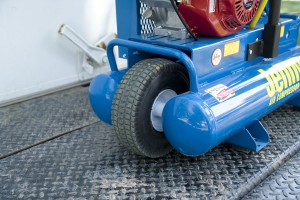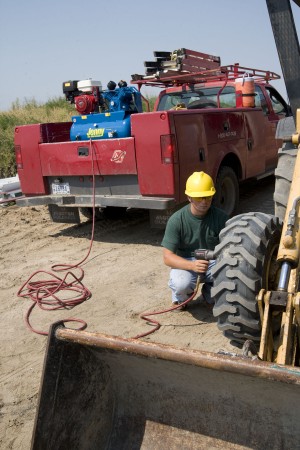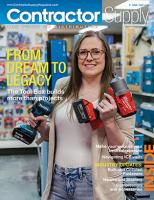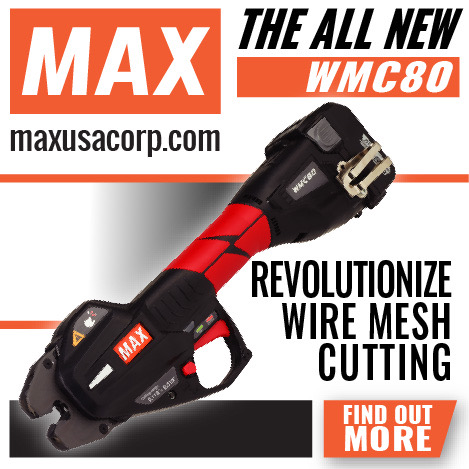Selling smart: Air compressors
Evaluating and selecting types of air compressors to sell involves more than just PSI
 Selecting the best sizes and models of air compressors to distribute can’t be that hard, right? All you have to figure out is about how much air most of your client base may need.
Selecting the best sizes and models of air compressors to distribute can’t be that hard, right? All you have to figure out is about how much air most of your client base may need.
Unfortunately, you’ll find it’s not quite that easy once you start looking into it. There’s PSI, HP and CFM. And what about SCFM, DSFM and ACFM? Simplex or duplex? Single-stage or two-stage?
Relax. You already understand your client base. We’ll help you understand compressors. Then it’s just a matter of connecting the dots between compressor models and customers’ applications.
Portability Needs
Let’s begin with the basics. Do most end-users work in shops? Or, do they move from one job site to another?
 Portability is one of the first things to consider. Will a hand-carry or wheeled-portable model be best, or would the customer benefit from a larger stationary unit? Consider the compressor’s weight, as well as the presence of wheels and handles if a portable machine is needed.
Portability is one of the first things to consider. Will a hand-carry or wheeled-portable model be best, or would the customer benefit from a larger stationary unit? Consider the compressor’s weight, as well as the presence of wheels and handles if a portable machine is needed.
The typical job site also will affect the type of power source best suited for end-users. If they tend to work in a remote area without access to electrical power, either from the grid or an on-site generator, the only choice is a gasoline engine model. This allows complete mobility both to and from the job site, as well as around the work area.
Environmental restrictions — such as emissions in a confined space or noise abatement — may cancel any benefit of a fuel-powered compressor, however. The gas model also will cost more up front and more to maintain over its service life. Contrarily, electric-motor counterparts do not provide as much horsepower as gas models.
Understanding CFM
Besides portability and power, capacity will directly impact what applications end-users will be able to perform. To get an idea of their size needs, add up the CFM (cubic feet per minute) requirements for all of the tools that likely will be used simultaneously in their field. Add an extra 30 percent to allow for unknown or uncommon compressor usage. CFM demands are listed on the tool and/or in the owner’s manual.
 Capacity, or volume — in other words, CFM — can be figured three ways.
Capacity, or volume — in other words, CFM — can be figured three ways.
1) First, displaced CFM (DCFM) offers a mathematical calculation of bore, stroke and rpm. It doesn’t, however, take into account other variables, such as temperature, atmospheric pressure, humidity, friction or heat dissipation. In other words, it means little in the working world.
2) Standard CFM (SCFM) better measures reality. It references the flow of free air in a standardized environment, such as 14.5 psi atmospheric pressure (the pressure at sea level), 68 degrees Fahrenheit and 0 percent humidity. Since this is a standardized metric, it’s the best figure to use in comparing air compressors across the board.
3)The third way to calculate CFM is actual CFM (ACFM), which figures variables for a specific situation. If the majority of end-users live in Anchorage, their ACFM needs would differ considerably from someone in Miami. These figures can be hard to get, however, and just as hard to calculate. For distributorship purposes, monitoring SCFM ratings will typically be the best option.
CFM also comes into the single-stage versus two-stage decision. What are the minimum operating pressures of the tools end-users are most likely to use? Single-stage compressors work well up to 150 psi. For more pressure, a two-stage compressor will need to be used.
So, what’s the big difference? A single-stage compressor usually has a higher CFM rating because the cylinder draws in air and compresses it with every rotation. A two-stage unit compresses the air up to an intermediate pressure in one or more cylinders, and then passes it on to another cylinder to finish. This passage, which is usually to an intercooler between stages, makes a two-stage compressor more efficient at high pressures.
Sizing Up Components
The end-user’s application will also impact the size of compressor tank needed. When quick, concentrated bursts of air are needed, such as with a nail gun, a smaller tank is best. If the compressor will be used for sustained periods — with tools such as board sanders, grinders and impact wrenches — a larger tank will work best. Think about it. It’s like blowing out a candle compared to blowing out a birthday cake covered with candles. You have to fill up your lungs for the birthday cake; the candle you can do with a puff.
Be sure to offer hose diameters and lengths suitable for most clients’ applications, as well. A 1/4-inch diameter hose won’t work very well if a 3/8-inch hose is needed to handle more tools or longer runs of hose.
Durability Decisions
Choosing compressors with durable features will contribute to a longer lasting machine, which leads to greater cost efficiency over time, resulting in more satisfied customers. It’s a positive domino effect. Investing in quality up front will pay long-term rewards for both distributors and clients.
 Long-term durability features to look for include a cast-iron cylinder, a heat-dissipating head, an efficient cooling system and structural protection for critical components and fittings. Also look for a heavy-duty steel frame and powder-coat or electrostatically applied paint to resist chipping and wear.
Long-term durability features to look for include a cast-iron cylinder, a heat-dissipating head, an efficient cooling system and structural protection for critical components and fittings. Also look for a heavy-duty steel frame and powder-coat or electrostatically applied paint to resist chipping and wear.
Anti-vibration feet will help keep the noise down, and more importantly, keep the compressor from rattling itself apart.
Examine compressor manufacturers before choosing a line, as well. Ask questions. Are air compressors the primary or sole business of the manufacturer? Does the company make its own products or source them from a third party? How long has the company been in the air compressor business? (All we know about the future is what we know about the past, so look at the company’s history in this market.)
Other questions include: Can the supplier answer all of your questions clearly and explain the subtleties that only an expert would know? What about the availability of technical help, parts and service and the distribution network?
Overall, the most important factor is analyzing your end-users’ most typical application usage. Every application has its own requirements and therefore, its own set of questions and necessities. Do you deal primarily with framing
contractors? Professional painters? Machine shop owners? Consider the end-users’ needs, and the most appropriate equipment option will be clear.
Remember, what you’re ultimately distributing is not an air compressor. It’s a solution to a contractor’s problem. Analyzing all the factors involved will ensure that the contractor receives a complete solution rather than a temporary fix.
About the author: Dan Leiss is president of Jenny Products, Inc., Somerset, PA. He can be reached at 814-445-3400.
















